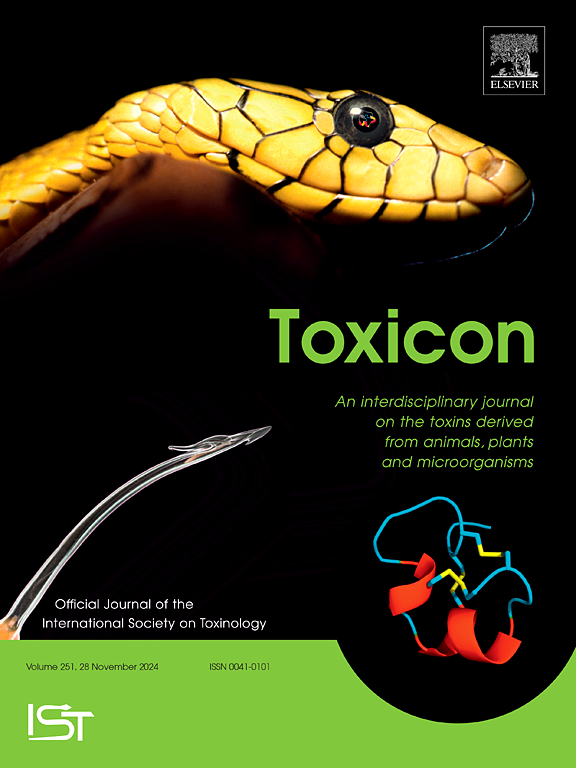纽约卡尤加湖中的异常麻痹性贝类中毒毒素。
IF 2.6
4区 医学
Q2 PHARMACOLOGY & PHARMACY
引用次数: 0
摘要
2017 年和 2018 年,纽约州卡尤加湖检测到蓝藻藻华,其中麻痹性贝类中毒毒素(PSPTs)是检测到的主要毒素。通过 HPLC 化学氧化法、受体结合测定法、ELISA 和 LC-MS/MS 对这些样本进行分析,证实了 PSPTs 的存在,但根据每种方法的理论基础,每种方法都得出了极不寻常的结果。这些毒素的结构无法确定,可能是 "不常见的 "或未阐明的 PSPT。本文章由计算机程序翻译,如有差异,请以英文原文为准。

Unusual paralytic shellfish poisoning toxins in Cayuga Lake, New York
Cyanobacteria blooms were detected in 2017 and 2018 in Cayuga Lake, New York, with paralytic shellfish poisoning toxins (PSPTs) the primary toxin detected. Analysis of these samples by HPLC with chemical oxidation, receptor binding assay, ELISA, and LC-MS/MS confirmed the presence of PSPTs but each method gave highly unusual results based on the theory establishing each method. The structures of the toxins could not be identified and may be ‘unusual’ or unelucidated PSPTs.
求助全文
通过发布文献求助,成功后即可免费获取论文全文。
去求助
来源期刊

Toxicon
医学-毒理学
CiteScore
4.80
自引率
10.70%
发文量
358
审稿时长
68 days
期刊介绍:
Toxicon has an open access mirror Toxicon: X, sharing the same aims and scope, editorial team, submission system and rigorous peer review. An introductory offer Toxicon: X - full waiver of the Open Access fee.
Toxicon''s "aims and scope" are to publish:
-articles containing the results of original research on problems related to toxins derived from animals, plants and microorganisms
-papers on novel findings related to the chemical, pharmacological, toxicological, and immunological properties of natural toxins
-molecular biological studies of toxins and other genes from poisonous and venomous organisms that advance understanding of the role or function of toxins
-clinical observations on poisoning and envenoming where a new therapeutic principle has been proposed or a decidedly superior clinical result has been obtained.
-material on the use of toxins as tools in studying biological processes and material on subjects related to venom and antivenom problems.
-articles on the translational application of toxins, for example as drugs and insecticides
-epidemiological studies on envenoming or poisoning, so long as they highlight a previously unrecognised medical problem or provide insight into the prevention or medical treatment of envenoming or poisoning. Retrospective surveys of hospital records, especially those lacking species identification, will not be considered for publication. Properly designed prospective community-based surveys are strongly encouraged.
-articles describing well-known activities of venoms, such as antibacterial, anticancer, and analgesic activities of arachnid venoms, without any attempt to define the mechanism of action or purify the active component, will not be considered for publication in Toxicon.
-review articles on problems related to toxinology.
To encourage the exchange of ideas, sections of the journal may be devoted to Short Communications, Letters to the Editor and activities of the affiliated societies.
 求助内容:
求助内容: 应助结果提醒方式:
应助结果提醒方式:


